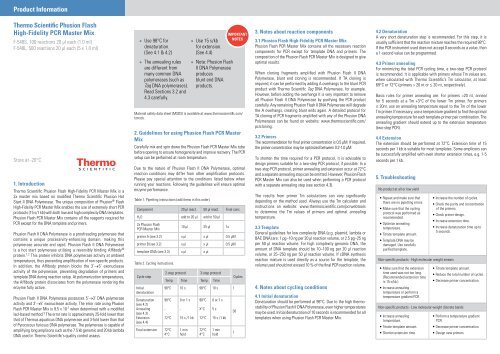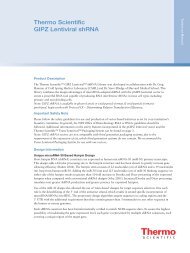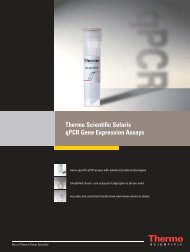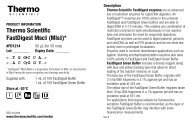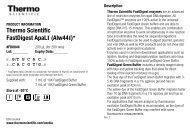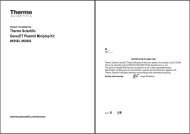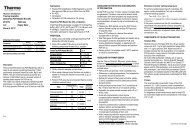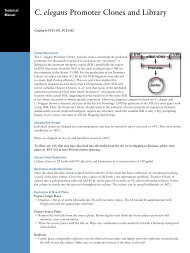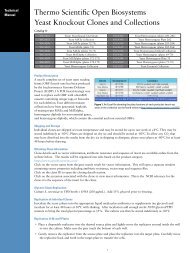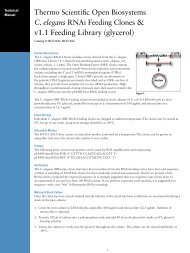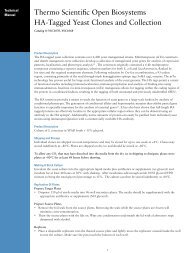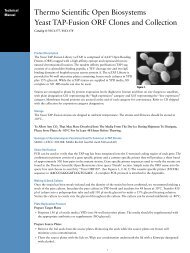Thermo Scientific Phusion Flash High-Fidelity PCR Master Mix ...
Thermo Scientific Phusion Flash High-Fidelity PCR Master Mix ...
Thermo Scientific Phusion Flash High-Fidelity PCR Master Mix ...
Create successful ePaper yourself
Turn your PDF publications into a flip-book with our unique Google optimized e-Paper software.
Product Information<br />
<strong>Thermo</strong> <strong>Scientific</strong> <strong>Phusion</strong> <strong>Flash</strong><br />
<strong>High</strong>-<strong>Fidelity</strong> <strong>PCR</strong> <strong>Master</strong> <strong>Mix</strong><br />
F-548S, 100 reactions 20 µl each (1.0 ml)<br />
F-548L, 500 reactions 20 µl each (5 x 1.0 ml)<br />
Store at -20°C<br />
1. Introduction<br />
<strong>Thermo</strong> <strong>Scientific</strong> <strong>Phusion</strong> <strong>Flash</strong> <strong>High</strong>-<strong>Fidelity</strong> <strong>PCR</strong> <strong>Master</strong> <strong>Mix</strong> is a<br />
2x master mix based on modified <strong>Thermo</strong> <strong>Scientific</strong> <strong>Phusion</strong> Hot<br />
Start II DNA Polymerase. The unique composition of <strong>Phusion</strong> ® <strong>Flash</strong><br />
<strong>High</strong>-<strong>Fidelity</strong> <strong>PCR</strong> <strong>Master</strong> <strong>Mix</strong> enables the use of extremely short <strong>PCR</strong><br />
protocols (15 s/1 kb) with both low and high complexity DNA templates.<br />
<strong>Phusion</strong> <strong>Flash</strong> <strong>PCR</strong> <strong>Master</strong> <strong>Mix</strong> contains all the reagents required for<br />
<strong>PCR</strong> except for the DNA template and primers.<br />
<strong>Phusion</strong> <strong>Flash</strong> II DNA Polymerase is a proofreading polymerase that<br />
contains a unique processivity-enhancing domain, making this<br />
polymerase accurate and rapid. <strong>Phusion</strong> <strong>Flash</strong> II DNA Polymerase<br />
is a hot start polymerase utilizing a reversibly binding Affibody ®<br />
protein. 1,2 This protein inhibits DNA polymerase activity at ambient<br />
temperatures, thus preventing amplification of non-specific products.<br />
In addition, the Affibody protein blocks the 3’→5’ exonuclease<br />
activity of the polymerase, preventing degradation of primers and<br />
template DNA during reaction setup. At polymerization temperatures,<br />
the Affibody protein dissociates from the polymerase rendering the<br />
enzyme fully active.<br />
<strong>Phusion</strong> <strong>Flash</strong> II DNA Polymerase possesses 5’→3’ DNA polymerase<br />
activity and 3’→5’ exonuclease activity. The error rate using <strong>Phusion</strong><br />
<strong>Flash</strong> <strong>PCR</strong> <strong>Master</strong> <strong>Mix</strong> is 9.5 x 10 -7 when determined with a modified<br />
lacI-based method. 3 The error rate is approximately 25-fold lower than<br />
that of Thermus aquaticus DNA polymerase and 3-fold lower than that<br />
of Pyrococcus furiosus DNA polymerase. The polymerase is capable of<br />
amplifying long amplicons such as the 7.5 kb genomic and 20 kb lambda<br />
DNA used in <strong>Thermo</strong> <strong>Scientific</strong>’s quality control assays.<br />
• Use 98°C for<br />
denaturation.<br />
(See 4.1 & 4.2)<br />
• The annealing rules<br />
are different from<br />
many common DNA<br />
polymerases (such as<br />
Taq DNA polymerases).<br />
Read Sections 3.2 and<br />
4.3 carefully.<br />
Material safety data sheet (MSDS) is available at www.thermoscientific.com/<br />
fzmsds.<br />
2. Guidelines for using <strong>Phusion</strong> <strong>Flash</strong> <strong>PCR</strong> <strong>Master</strong><br />
<strong>Mix</strong><br />
Carefully mix and spin down the <strong>Phusion</strong> <strong>Flash</strong> <strong>PCR</strong> <strong>Master</strong> <strong>Mix</strong> tube<br />
before opening to ensure homogeneity and improve recovery. The <strong>PCR</strong><br />
setup can be performed at room temperature.<br />
Due to the nature of <strong>Phusion</strong> <strong>Flash</strong> II DNA Polymerase, optimal<br />
reaction conditions may differ from other amplification protocols.<br />
Please pay special attention to the conditions listed below when<br />
running your reactions. Following the guidelines will ensure optimal<br />
enzyme performance.<br />
Table 1. Pipetting instructions (add items in this order).<br />
Component 20 µl react. 50 µl react. Final conc.<br />
H 2 O add to 20 µl add to 50 µl<br />
2x <strong>Phusion</strong> <strong>Flash</strong><br />
<strong>PCR</strong> <strong>Master</strong> <strong>Mix</strong><br />
10 µl 25 µl 1x<br />
primer A (see 3.2) x µl x µl 0.5 µM<br />
primer B (see 3.2) x µl x µl 0.5 µM<br />
template DNA (see 3.3) x µl x µl<br />
Table 2. Cycling instructions.<br />
Cycle step<br />
Initial<br />
denaturation<br />
Denaturation<br />
(see 4.2)<br />
Annealing<br />
(see 4.3)<br />
Extension<br />
(see 4.4)<br />
Final extension<br />
2-step protocol 3-step protocol<br />
Temp. Time Temp. Time<br />
98°C 10 s 98°C 10 s 1<br />
98°C<br />
-<br />
72°C<br />
72°C<br />
4°C<br />
0 or 1 s<br />
-<br />
15 s /1 kb<br />
1 min<br />
hold<br />
• Use 15 s/kb<br />
for extension.<br />
(See 4.4)<br />
• Note: <strong>Phusion</strong> <strong>Flash</strong><br />
II DNA Polymerase<br />
produces<br />
blunt end DNA<br />
products.<br />
98°C<br />
X°C<br />
72°C<br />
72°C<br />
4°C<br />
0 or 1 s<br />
5 s<br />
15 s /1 kb<br />
1 min<br />
hold<br />
IMPoRTanT<br />
noTeS<br />
Cycles<br />
30<br />
1<br />
3. notes about reaction components<br />
3.1 <strong>Phusion</strong> <strong>Flash</strong> <strong>High</strong>-<strong>Fidelity</strong> <strong>PCR</strong> <strong>Master</strong> <strong>Mix</strong><br />
<strong>Phusion</strong> <strong>Flash</strong> <strong>PCR</strong> <strong>Master</strong> <strong>Mix</strong> contains all the necessary reaction<br />
components for <strong>PCR</strong> except for template DNA and primers. The<br />
composition of the <strong>Phusion</strong> <strong>Flash</strong> <strong>PCR</strong> <strong>Master</strong> <strong>Mix</strong> is designed to give<br />
optimal results.<br />
When cloning fragments amplified with <strong>Phusion</strong> <strong>Flash</strong> II DNA<br />
Polymerase, blunt end cloning is recommended. If TA cloning is<br />
required, it can be performed by adding A overhangs to the blunt <strong>PCR</strong><br />
product with <strong>Thermo</strong> <strong>Scientific</strong> Taq DNA Polymerase, for example.<br />
However, before adding the overhangs it is very important to remove<br />
all <strong>Phusion</strong> <strong>Flash</strong> II DNA Polymerase by purifying the <strong>PCR</strong> product<br />
carefully. Any remaining <strong>Phusion</strong> <strong>Flash</strong> II DNA Polymerase will degrade<br />
the A overhangs, creating blunt ends again. A detailed protocol for<br />
TA cloning of <strong>PCR</strong> fragments amplified with any of the <strong>Phusion</strong> DNA<br />
Polymerases can be found on website: www.thermoscientific.com/<br />
pcrcloning.<br />
3.2 Primers<br />
The recommendation for final primer concentration is 0.5 µM. If required,<br />
the primer concentration may be optimized between 0.2-1.0 µM.<br />
To shorten the time required for a <strong>PCR</strong> protocol, it is advisable to<br />
design primers suitable for a two-step <strong>PCR</strong> protocol, if possible. In a<br />
two-step <strong>PCR</strong> protocol, primer annealing and extension occur at 72°C<br />
and a separate annealing step can be omitted. However, <strong>Phusion</strong> <strong>Flash</strong><br />
<strong>PCR</strong> <strong>Master</strong> <strong>Mix</strong> can also be used when performing a <strong>PCR</strong> protocol<br />
with a separate annealing step (see section 4.3).<br />
The results from primer Tm calculations can vary significantly<br />
depending on the method used. Always use the Tm calculator and<br />
instructions on website: www.thermoscientific.com/pcrwebtools<br />
to determine the Tm values of primers and optimal annealing<br />
temperature.<br />
3.3 Template<br />
General guidelines for low complexity DNA (e.g. plasmid, lambda or<br />
BAC DNA) are: 1 pg–10 ng per 20 µl reaction volume, or 2.5 pg–25 ng<br />
per 50 µl reaction volume. For high complexity genomic DNA, the<br />
amount of DNA template should be 10–100 ng per 20 µl reaction<br />
volume, or 25–250 ng per 50 µl reaction volume. If cDNA synthesis<br />
reaction mixture is used directly as a source for the template, the<br />
volume used should not exceed 10 % of the final <strong>PCR</strong> reaction volume.<br />
4. notes about cycling conditions<br />
4.1 Initial denaturation<br />
Denaturation should be performed at 98°C. Due to the high thermostability<br />
of <strong>Phusion</strong> <strong>Flash</strong> II DNA Polymerase, even higher temperatures<br />
may be used. Initial denaturation of 10 seconds is recommended for all<br />
templates when using <strong>Phusion</strong> <strong>Flash</strong> <strong>PCR</strong> <strong>Master</strong> <strong>Mix</strong>.<br />
4.2 Denaturation<br />
A very short denaturation step is recommended. For this step, it is<br />
usually sufficient that the reaction mixture reaches the required 98°C.<br />
If the <strong>PCR</strong> instrument used does not accept 0 seconds as a value, then<br />
a 1-second value can be programmed.<br />
4.3 Primer annealing<br />
For minimizing the total <strong>PCR</strong> cycling time, a two-step <strong>PCR</strong> protocol<br />
is recommended. It is applicable with primers whose Tm values are,<br />
when calculated with <strong>Thermo</strong> <strong>Scientific</strong>’s Tm calculator, at least<br />
69°C or 72°C (primers > 20 nt or ≤ 20 nt, respectively).<br />
Basic rules for primer annealing are: For primers >20 nt, anneal<br />
for 5 seconds at a Tm +3°C of the lower Tm primer. For primers<br />
≤ 20nt, use an annealing temperature equal to the Tm of the lower<br />
Tm primer. If necessary, use a temperature gradient to find the optimal<br />
annealing temperature for each template-primer pair combination. The<br />
annealing gradient should extend up to the extension temperature<br />
(two-step <strong>PCR</strong>).<br />
4.4 extension<br />
The extension should be performed at 72°C. Extension time of 15<br />
seconds per 1 kb is suitable for most templates. Some amplicons can<br />
be successfully amplified with even shorter extension times, e.g. 1-5<br />
seconds per 1 kb.<br />
5. Troubleshooting<br />
No product at all or low yield<br />
• Repeat and make sure that<br />
there are no pipetting errors.<br />
• Make sure that the cycling<br />
protocol was performed as<br />
recommended.<br />
• Optimize annealing<br />
temperature.<br />
• Titrate template amount.<br />
• Template DNA may be<br />
damaged. Use carefully<br />
purified template.<br />
Non-specific products - <strong>High</strong> molecular weight smears<br />
• Make sure that the extension<br />
time used was not too long.<br />
(Recommended extension time<br />
is 15 s/kb.)<br />
• Increase annealing<br />
temperature or perform a<br />
temperature gradient <strong>PCR</strong>.<br />
• Increase the number of cycles.<br />
• Check the purity and concentration<br />
of the primers.<br />
• Check primer design.<br />
• Increase extension time.<br />
• Increase denaturation time up to<br />
5 seconds.<br />
• Titrate template amount.<br />
• Reduce the total number of cycles.<br />
• Decrease primer concentration.<br />
Non-specific products - Low molecular weight discrete bands<br />
• Increase annealing<br />
temperature.<br />
• Titrate template amount.<br />
• Shorten extension time.<br />
• Perform a temperature gradient<br />
<strong>PCR</strong>.<br />
• Decrease primer concentration.<br />
• Design new primers.
6. Component specifications<br />
6.1 <strong>Phusion</strong> <strong>Flash</strong> II Dna Polymerase<br />
<strong>Thermo</strong>stable <strong>Phusion</strong> DNA Polymerases are purified from recombinant<br />
E. coli strains. <strong>Phusion</strong> DNA Polymerases possess the following<br />
activities: 5’→3’ DNA polymerase activity and 3’→5’ exonuclease<br />
activity. The Affibody ligand is purified from an E. coli strain carrying<br />
a plasmid encoding Affibody protein. <strong>Phusion</strong> <strong>Flash</strong> DNA Polymerase<br />
is free of contaminating endo- and exonucleases.<br />
Dna amplification assay: Performance in <strong>PCR</strong> is tested by the<br />
amplification of a 7.5 kb fragment of genomic DNA and a 20 kb<br />
fragment of lambda DNA.<br />
7. References<br />
1. Nord K. et al. (1997) Nature Biotechnol. 15: 772–777.<br />
2. Wikman M. et al. (2004) Protein Eng. Des. Sel. 17: 455–462.<br />
3. Frey M. & Suppmann B. (1995) Biochemica 2: 34–35.<br />
Shipping and storage<br />
<strong>Phusion</strong> DNA Polymerase is shipped on gel ice. Upon arrival, store the<br />
components at -20°C.<br />
Technical support<br />
US: techservice.genomics@thermofisher.com<br />
Europe, Asia, Rest of World:<br />
techservice.emea.genomics@thermofisher.com<br />
Web: www.thermoscientific.com/phusion<br />
Tm-calculator: www.thermoscientific.com/pcrwebtools<br />
Product use limitation<br />
This product has been developed and is sold exclusively for research purposes and<br />
in vitro use only. This product has not been tested for use in diagnostics or drug<br />
development, nor are they suitable for administration to humans or animals.<br />
notice to Purchaser: Limited License<br />
The purchase price of this product includes a limited, non-transferable license under<br />
national patents from EP 0 547 920 B1, owned by New England Biolabs, Inc., to use this<br />
product. No other license under these patents is conveyed expressly or by implication<br />
to the purchaser by the purchase of this product.<br />
The purchase price of this product includes a limited, nontransferable license under U.S.<br />
and foreign patents owned by BIO-RAD Laboratories, Inc., to use this product. No other<br />
license under these patents is conveyed expressly or by implication to the purchaser<br />
by the purchase of this product.<br />
Use of this product is covered by US Patent No. 6,127,155. The purchase of this product<br />
includes a limited, non-transferable immunity from suit under the foregoing patent<br />
claims for using only this amount of product for the purchaser’s own internal research.<br />
No right under any other patent claim, no right to perform any patented method and no<br />
right to perform commercial services of any kind, including without limitation reporting<br />
the results of purchaser’s activities for a fee or other commercial consideration, is<br />
conveyed expressly, by implication, or by estoppel. This product is for research use only.<br />
Diagnostic uses under Roche patents require a separate license from Roche. Further<br />
information on purchasing licenses may be obtained by contacting the Director of<br />
Licensing, Applied Biosystems, 850 Lincoln Centre Drive, Foster City, California<br />
This product is sold under license from Affibody AB, Sweden.<br />
Designed and manufactured according to certified ISO9001:2008 processes.<br />
Affibody ® is a registered trademark of Affibody AB, Sweden.<br />
© 2011 <strong>Thermo</strong> Fisher <strong>Scientific</strong> Inc. All rights reserved. All other trademarks are the<br />
property of <strong>Thermo</strong> Fisher <strong>Scientific</strong> Inc. and its subsidiaries.<br />
v1_07.2011


